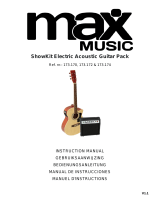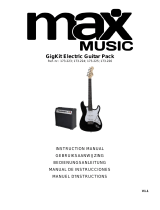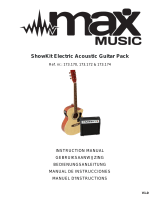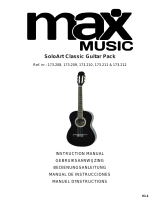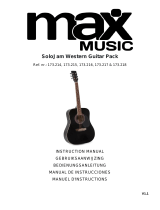Page is loading ...

K200serieswww.lexibook.com
W105 x H148 mm
K200seriesIM1128_V14_325.indd 1 20/3/18 11:15 am

7
ENGLISH
Discovering your guitar
Tuning your guitar
Discover your new guitar and become familiar with the different parts of your instrument by studying the
diagram on the first page of the booklet.
Your guitar has six strings (nylon): three left strings for playing lower notes and three right strings for playing
higher notes.
When unpacking, ensure that the following elements are included:
1 x Guitar / 1 x Instruction manual
WARNING: All packaging materials, such as tape, plastic sheets, wire ties and tags are not part of this
product and should be discarded for your child’s safety.
a) Using a piano
Play middle E/Mi on the piano (middle E/Mi
is the 12th white key, counting from the left
end of the standard piano keyboard, which is
composed of 88 keys). Adjust the 6th string (E/
Mi) cord up until it sounds the same. Refer to
the diagram shown to tune the remaining five
strings in the same way.
Start from
this string!
1. Headstock 5. Strings (x6) 9. Frets (x12)
2. Neck 6. Saddle 10. Fingerboard/Fretboard
3. Body 7. Soundboard/Top 11. Nut
4. Bridge 8. Soundhole 12. Tuning machines/Keys (x6)
12
th
key 15
th
key 18
th
key 21
st
key 23
rd
key 26
th
key
A
G
B
E
3
2
1
6
5
4
D
E
A
1
st
fret
2
nd
fret
3
rd
fret
4
th
fret
5
th
fret
6
th
fret
1
st
string
2
nd
string
3
rd
string
4
th
string
5
th
string
6
th
string
Before you start playing, it is recommended that you properly tune your
guitar to avoid playing any wrong notes! To do this, use the tuning keys
located at the top of the neck.
Each key is attached to a string. When you turn the key clockwise, the
string will produce a lower tone, and if you turn the key in the opposite
direction, the string will produce a higher tone.
Your guitar is properly tuned when all the strings, played in an open
position (without applying your fingers on the frets), produce the notes
indicated on diagram A.
Warning: Be careful when turning the keys counter clockwise. If you
turn them too much, the strings may become too tight and break.
Start from the 6th string (thickest and lowest in tone) and continue until
the 1st string (thinnest and highest in tone) is tuned. Follow the order
of the numbers presented in the diagram opposite. If you start in the
opposite direction, your guitar may have a greater tendency to go out
of tune as you play.
There are several methods for tuning a guitar. The easiest one consists
in using an electronic tuner. It will definitely simplify the tuning of your
guitar. If you don’t have one, you can use the methods described below.
B
E
A
D G B E
K200seriesIM1128_V14_325.indd 7 20/3/18 11:15 am

8
9
ENGLISH
Holding your guitar
In general, for both right- and left-handers, the guitar is held in the following manner: left hand on the neck
and right hand on the body. It is possible to hold your guitar left-handedly (right hand on the neck and left
hand on the box), but you will have to change the bridge saddle in order to reverse the strings. In both cases,
hold the instrument by your strumming arm with the back of the guitar against your body.
There are many ways to hold your guitar. The most important thing is that you feel comfortable.
You may also choose to play standing
up with the guitar chest high.
1 2
You may, for example, sit down and
balance the guitar on your lap.
C
G
B
E
D
E
A
1
st
fret
2
nd
fret
3
rd
fret
4
th
fret
5
th
fret
6
th
fret
b) Tuning by ear (with one reference string) (see diagram C)
First tune the 5
th
string (A/La) of your guitar using:
1. a piano: adjust the string up until it sounds the same as the 15
th
white key of
the standard piano keyboard;
2. a tuning fork (A/La 440Hz): adjust the string up until its tone is the same as
the tuning fork, but 2 octaves lower.
Playing the 5th string open, put and keep your finger between the 4
th
and
the 5
th
fret on the 6
th
string, and adjust the string up until it sounds the same
as the 5
th
string (A/La);
- Press on the 5th fret of the 6th string. Adjust the string’s tuning key until it
sounds like the 5th string (La/A). See fig.
A
.
- Press on the 5th fret of the 5th string. Adjust the string’s tuning key until it
sounds like the 4th string (Re/D). See fig.
D
.
- Press on the 5th fret of the 4th string. Adjust the string’s tuning key until it
sounds like the 3rd string (Sol/G). See fig.
G
.
- Press on the 4th fret of the 3rd string. Adjust the string’s tuning key until it
sounds like the 2nd string (Si/B). See fig.
B
.
- Press on the 5th fret of the 2nd string. Adjust the string’s tuning key until it
sounds like the 1st string (Mi/E). See fig.
E
.
K200seriesIM1128_V14_325.indd 8 20/3/18 11:15 am

8
9
ENGLISH
Thumb position
Position of the
other fingers
Where to put your hands
When playing guitar, you must put one hand on the neck and other on the body.
Your left hand
The fingers of your left hand are used to press down on the strings and to select notes. It is therefore
important to properly position your left hand in order to have enough strength in your fingers.
Place your thumb flat under the neck, and then curve the other fingers over the front of the neck. Make a
hollow in your hand so that your fingers are placed over top of the strings like a claw. You can now press
harder on the strings using your fingertips.
When you start playing, your fingers will not be used to pressing hard on the strings, and it is possible that
calluses will form on your fingertips. Do not worry, this is normal! Keep your nails short so they are not in the
way when you play.
To be able to easily move your hand along the neck, maintain a slight distance between your elbow and the
guitar body.
How to strum the strings
With a flick of the wrist, quickly run your right hand over
the strings. Each strum corresponds to one beat.
Strum the strings using your thumb or the nail (reverse) of your index finger. Strum from the 6th string (the
thickest / top string) to the 1st string (the thinnest / highest string).
Your right hand
Place your right hand on the strings over the soundhole (8). Use your right hand to strum.
K200seriesIM1128_V14_325.indd 9 20/3/18 11:15 am

11
10
11
ENGLISH
Maintenance and warranty
The finish on your unit may be cleaned with a dust cloth and cared for as other furniture.
Note: Please keep this instruction manual, it contains important information.
This product is covered by our 2-year warranty.
For any claim under the warranty or after sale service, please contact your distributor and present a
valid proof of purchase. Our warranty covers any manufacturing material and workmanship defect, with
the exception of any deterioration arising from the non-observance of the instruction manual or from any
careless action implemented on this item (such as dismantling, exposition to heat and humidity, etc.). It is
recommended to keep the packaging for any further reference. In a bid to keep improving our services, we
could implement modification on the colours and the details of the product shown on the packaging.
WARNING! Not suitable for children under 3 years. Choking Hazard – Small parts.
Reference:
K200series
Designed and developed in Europe – Made in China
©LEXIBOOK®
United Kingdom & Ireland
For after-sales service, please contact us at
[email protected] or +33 1 84 88 58 59.
www.lexibook.com
A few basic chords
1
2
3
4
D
1
3
2
C
1
3
2
E
1
3
2
4
G
3
2
A
1
3
2
Practice playing a few basic chords. The diagrams below represent your guitar neck. The lower horizontal
lines correspond to the lower strings (thick strings) and those above to the higher strings (thin strings). The
vertical lines are the frets. Each finger is assigned a number. Use the fingers of your left hand to press the
strings by taking into account the numbers that correspond to those associated with your fingers. You can
then play the notes on the different frets of the strings.
Notes:
• The vertical line represents the index finger which, instead of pressing the string with only the fingertip,
presses down on all the strings using the entire length of the finger. The horizontal line corresponds to a
string that is not played.
• For improved playing and better application of pressure on the strings, keep the nails on your left hand well
trimmed.
4
F
3
2
1
4
B
3
2
1
K200seriesIM1128_V14_325.indd 10 20/3/18 11:15 am
/
